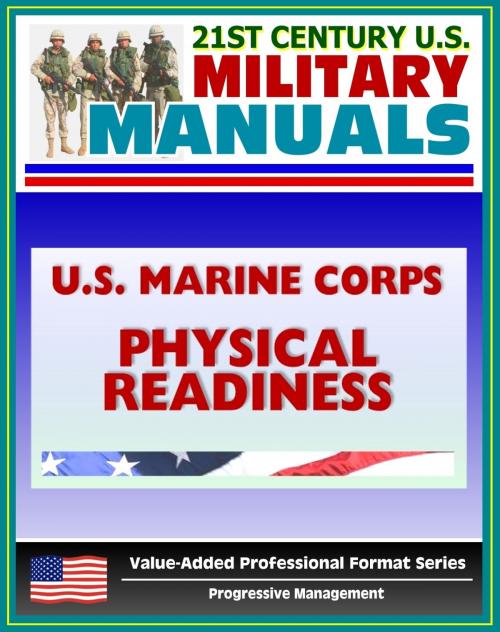21st Century U.S. Military Manuals: U.S. Marine Corps (USMC) Marine Physical Readiness Training for Combat MCRP 3-02A
Nonfiction, History, Military, Weapons, Naval| Author: | Progressive Management | ISBN: | 9781466035072 |
| Publisher: | Progressive Management | Publication: | February 16, 2012 |
| Imprint: | Smashwords Edition | Language: | English |
| Author: | Progressive Management |
| ISBN: | 9781466035072 |
| Publisher: | Progressive Management |
| Publication: | February 16, 2012 |
| Imprint: | Smashwords Edition |
| Language: | English |
Part of our value-added professional format series of U.S. military manuals, this U.S. Marine Corps manual provides the information and references necessary to establish and conduct physical conditioning programs to prepare Marines for the physical demands of combat.
Physical fitness training in the Marine Corps has one purpose: to prepare Marines to physically withstand the rigors of combat. All other goals of physical fitness training are subordinate to and must support attainment of this goal. The idea that only infantry or reconnaissance units and their attachments normally face physically demanding combat is wrong. This error must not influence the priority commanders of combat support , combat service support, aviation, and headquarters units give to physical fitness for combat. Physical fitness for combat has a high priority for all Marines. A sound, effective unit program, requiring limited time and material, offers a greater payoff in combat than many more expensive and time-consuming training programs. This handbook describes the concept and provides the ingredients of a program for commanders to use in carrying out one of their most serious responsibilities: ensuring that their Marines are physically ready for combat.
This handbook provides guidance for all leaders, trainers, and planners of physical training programs. It describes unit physical fitness for combat training in the following chapters:
a. Physical Readiness Leadership. Chapter 1 provides guidance to leaders in the conduct of physical combat readiness training. b. Physical Readiness Training Programs. Chapter 2 discusses how to structure programs to meet physical readiness goals in a variety of combat training situations. c. Physical Conditioning Activities. Chapter 3 discusses the primary physical conditioning activities which commanders may use to attain readiness for combat goals. Sections in this chapter address foot marches under load, strength-building activities, and activities which build confidence and the aggressive spirit needed in combat. d. Combat Water Survival. As an amphibious force, Marines cannot ignore the importance of combat water survival training. Chapter 4 describes a program for commanders to conduct this training. e. Competitive Conditioning Activities. Chapter 5 describes competitive activities which stress the relationship to combat actions, featuring team-building types of competition. f. Evaluation of Performance During Training. Chapter 6 describes tests which measure individual and unit physical fitness for combat. g. The Human Body. Chapter 7 covers the structure and functioning of the body.
As a bonus, this reproduction includes the Marine Corps Manual, the basic publication of the United States Marine Corps issued by the Commandant of the Marine Corps and approved by the Secretary of the Navy - sold separately for $7.99. It is a regulatory publication for the Department of the Navy as defined in U.S. Navy Regulations. The Marine Corps Manual is designed primarily for use by Marine Corps commanders and their staffs, Navy officers exercising command over Marines, the staff of the Commandant of the Marine Corps, and the staffs of the bureaus and offices of the Navy Department. Contents: Chapter 1 - General Administration And Management * Chapter 2 - Manpower * Chapter 3 - Operations And Readiness * Chapter 4 - Logistics
Part of our value-added professional format series of U.S. military manuals, this U.S. Marine Corps manual provides the information and references necessary to establish and conduct physical conditioning programs to prepare Marines for the physical demands of combat.
Physical fitness training in the Marine Corps has one purpose: to prepare Marines to physically withstand the rigors of combat. All other goals of physical fitness training are subordinate to and must support attainment of this goal. The idea that only infantry or reconnaissance units and their attachments normally face physically demanding combat is wrong. This error must not influence the priority commanders of combat support , combat service support, aviation, and headquarters units give to physical fitness for combat. Physical fitness for combat has a high priority for all Marines. A sound, effective unit program, requiring limited time and material, offers a greater payoff in combat than many more expensive and time-consuming training programs. This handbook describes the concept and provides the ingredients of a program for commanders to use in carrying out one of their most serious responsibilities: ensuring that their Marines are physically ready for combat.
This handbook provides guidance for all leaders, trainers, and planners of physical training programs. It describes unit physical fitness for combat training in the following chapters:
a. Physical Readiness Leadership. Chapter 1 provides guidance to leaders in the conduct of physical combat readiness training. b. Physical Readiness Training Programs. Chapter 2 discusses how to structure programs to meet physical readiness goals in a variety of combat training situations. c. Physical Conditioning Activities. Chapter 3 discusses the primary physical conditioning activities which commanders may use to attain readiness for combat goals. Sections in this chapter address foot marches under load, strength-building activities, and activities which build confidence and the aggressive spirit needed in combat. d. Combat Water Survival. As an amphibious force, Marines cannot ignore the importance of combat water survival training. Chapter 4 describes a program for commanders to conduct this training. e. Competitive Conditioning Activities. Chapter 5 describes competitive activities which stress the relationship to combat actions, featuring team-building types of competition. f. Evaluation of Performance During Training. Chapter 6 describes tests which measure individual and unit physical fitness for combat. g. The Human Body. Chapter 7 covers the structure and functioning of the body.
As a bonus, this reproduction includes the Marine Corps Manual, the basic publication of the United States Marine Corps issued by the Commandant of the Marine Corps and approved by the Secretary of the Navy - sold separately for $7.99. It is a regulatory publication for the Department of the Navy as defined in U.S. Navy Regulations. The Marine Corps Manual is designed primarily for use by Marine Corps commanders and their staffs, Navy officers exercising command over Marines, the staff of the Commandant of the Marine Corps, and the staffs of the bureaus and offices of the Navy Department. Contents: Chapter 1 - General Administration And Management * Chapter 2 - Manpower * Chapter 3 - Operations And Readiness * Chapter 4 - Logistics















